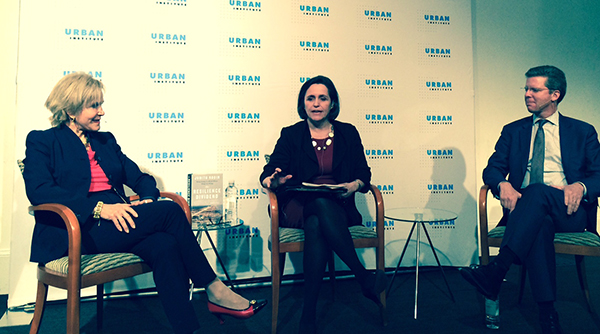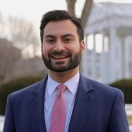
The National Climate Assessment was clear: The intensity of storms and rates of rainfall associated with hurricanes are projected to worsen with the warming climate. For the folks who live on the frontlines of the impacts of climate change– like the communities in Southeast Florida – the ruthless reality of extreme weather events are all too familiar. For them, and for countless communities from coast-to-coast, the economic case for investment in climate preparedness and resilience is also much too familiar. That is why these communities are taking action; and that is why resilience is becoming a bigger part of the public discourse – like yesterday’s Urban Institute event with Shaun Donovan, Director of the Office of Management and Budget, Judith Rodin, President of The Rockefeller Foundation and Sarah Rosen Wartell, President of The Urban Institute. The discussion focused on building resilient communities, the role of philanthropy in partnering with public leaders, and the impact of disasters on vulnerable populations.

Director Donovan noted that the President’s 2016 Budget provides the necessary tools, technical assistance, and on-the-ground partnership to support investment in climate preparedness and resilience.
The motivation to act now is simple: Why wait until after extreme weather hits?
When it came to their children’s health, Southeast Floridians decided they would not wait. In 2001, the community decided to invest in a robust retrofit of the Miami Children’s Hospital – they decided to build a glass fiber reinforced concrete “cocoon” around the hospital. That investment paid off: When Hurricanes Frances and Jeanne hit, the Children’s Hospital didn’t miss a beat. In fact, it provided a safe place to over 60 children who lived at home, were evacuated, and needed access to ventilators or other electrically-powered medical equipment. The theory proved right: The community took action, and, in the face of extreme weather, the Children’s Hospital endured.
Southeast Florida had good partners. The $11.3 million project was supported by a $5 million grant from the Federal Emergency Management Agency (FEMA). And studies – concluding that Americans save $3-$4 for every dollar invested in pre-disaster mitigation – show that these types of Federal grants are regularly a good investment, not just in Southeast Florida. That is why the President’s Budget scales up investment in programs like the FEMA Pre-disaster Mitigation Grant Program, proposing $200 million to help protect people and structures. This is an increase of $175 million over current funding levels.
The goal for investment in climate preparedness and resilience is clear: to proactively reduce the risks communities and ecosystems face, rather than waiting until after disaster strikes. These forward-thinking investments will not only save lives, but will save communities and taxpayers the costs associated with recovering from the next weather-related emergency for which they were not prepared; they include:
- Flood Resilience. The Budget includes $400 million for National Flood Insurance Program Risk Mapping efforts, an increase of $184 million over current funding levels to help communities and businesses understand what areas pose flood risks. The Budget also includes $200 million for the United States Department of Agriculture (USDA) to emphasize watershedscale planning and land treatment efforts and aid communities in planning and implementing mitigation and adaptation projects for extreme weather events.
- Drought Resilience. The Budget strongly supports USDA in its efforts to integrate climate considerations into existing programs and to use programs to drive resilience. For example, through its regional Climate Hubs, the Department will provide information and guidance to farmers, ranchers, and forest landowners on the latest technologies and risk management strategies to help them implement climate-smart tactics. This effort is complemented by $89 million for the Department of Interior (DOI) WaterSMART program, which promotes water conservation initiatives and technological breakthroughs.
- Wildland Fire Resilience. The Administration is committed to ensuring that adequate funds are available to fight wildland fires, protect communities and human lives, and implement appropriate land management activities to improve the resiliency of the Nation’s forests and rangelands. To accomplish this, the Budget proposes to establish a new funding framework for wildland fire suppression, similar to how other natural disasters are currently funded.
- On-the-Ground Partnership with Local Communities. The Budget provides $4 million to support a Resilience Corps pilot program at the Corporation for National and Community Service. This pilot program will support roughly 200 AmeriCorps members to assist communities in planning for and addressing the impacts of climate change. The Budget also includes $2 million for the National Oceanic and Atmospheric Administration (NOAA) to train the Resilience Corps members. In addition to standing up a new Resilience Corps, the Budget also scales up on-the-ground programs that are already at work—such as the Army Corps of Engineers’ Silver Jackets—by providing $31 million for the Corps of Engineers to provide local communities with technical and planning assistance regarding the development and implementation of nonstructural approaches to manage and reduce flood risk.
The exposure of the Federal budget to climate risks provides yet another call to action for policymakers. Over the last decade, the Federal Government has incurred over $300 billion in direct costs due to extreme weather and fire alone, including domestic disaster response and relief ($176 billion), flood insurance ($24 billion), crop insurance ($61 billion), and wildland fire management ($34 billion). While it is not possible to identify the portion of these costs incurred as a result of climate change, costs for each of these Federal programs have been increasing and can be expected to continue to increase as the impacts of climate change intensify.
Communities like Southeast Florida – a White House Climate Action Champion – are modeling how we should respond to one of the most significant long-term challenges that our country and our planet faces. The President’s Budget provides the necessary tools, technical assistance, and on-the-ground partnership to support communities like theirs, and the countless others from coast-to-coast that are dealing with the impacts of climate change in the best way: by taking action.


